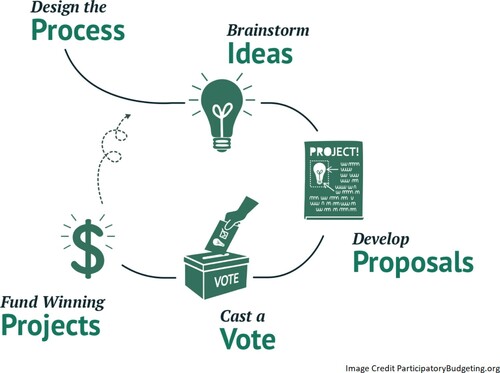Effective citizen engagement in the co-creation of services is rare. Participatory Budgeting (PB) is a tool which gives citizens the opportunity to suggest, develop, design, and vote on projects and services in their community. In this article, I argue, that by changing power dynamics, PB is one method which can ensure the effective co-creation of social innovation.
Issues with co-creation
As organizations shift from the New Public Management paradigm, service providers are being encouraged to co-create services ‘with’ service users rather than designing services ‘for’ them. This requires a new skillset and change in mindset (Strokosch & Osborne, Citation2020). Citizens are now the ‘experts’ from their lived experience, and professionals are the facilitators—harnessing their expertise.
Despite changing expectations, cuts to local government budgets means there is less time and resources to implement this new way of working. Subsequently, providers risk continuing to adopt ‘consultative’ rather than ‘collaborative’ approaches to co-creation, which limit opportunities for service users to truly influence decisions. Unless power relations are challenged in different ways, power remains with the service provider and innovative changes to services are unlikely (Farr, Citation2018). Lack of transparency in decision-making processes and outcomes also restricts the extent to which a service is truly ‘co-created’. PB addresses these issues by changing power dynamics and creating a transparent decision-making process with multiple opportunities for participation.
What is PB?
PB gives citizens an equal opportunity to suggest project ideas, deliberate over which ideas are best and vote for those they feel should be allocated resources. The project with the most votes must be implemented and the cycle begins again (see ). The most effective forms of PB engage citizens at each part of this process to deliver truly co-created services. However, some PB projects offer few opportunities to engage and may only involve people in one or two stages, limiting the opportunity for true co-creation.
PB started in 1988 in the city of Porto Alegre, Brazil to address issues of corruption and trust in political institutions. The authorities implemented a robust, transparent PB exercise, allowing local citizens to suggest project ideas, deliberate over funding allocation and vote on which projects were implemented. PB in Porto Alegre is often considered to be one of the most successful PB experiments, as it empowered local people by changing the relationship between state and civil society, with truly co-created innovative solutions to local issues (Novy & Leubolt, Citation2006).
However, subsequent PB experiments across the EU have generally not been as successful in transforming service delivery or participants’ views of political institutions. When practiced effectively, there have been positive impacts with innovative co-created services based on citizen’s needs (Dzinic et al., Citation2016). Conversely, when PB has not been implemented effectively, there has been little impact, as people felt they could not truly co-create services or influence decisions (Wilkinson et al., Citation2019).
PB as a social innovation
There remains debate over what qualifies as ‘social innovation’. However, I believe PB fits into almost any definition as it is ‘social in both its means and ends’ (Murray et al., Citation2010). By changing the relationship between service providers and citizens, and demonstrating a direct impact from involvement, PB can deliver a more inclusive political process and encourage participation by those who are disengaged or disillusioned by traditional democratic methods. PB can also result in more socially innovative outputs, as citizens suggest projects which truly reflect their needs, often prioritizing social justice and innovation (Sintomer et al., Citation2013). Therefore, PB is a social innovation in itself, with co-creation at its heart, and an approach which can produce social innovations through effective implementation.
PB as the key to true co-creation
PB is often perceived as simply allowing citizens to vote on resource allocation decisions. However, PB is most effective when citizens have the opportunity to be involved in each stage of the PB process, which mirrors the four elements of co-creation (Nabatchi et al., Citation2017). Whether it be prioritizing resources (co-commissioning); designing projects (co-design); assisting project delivery (co-delivery); or voting on and monitoring project implementation (co-assessment), PB enables citizens to be involved at each stage of the development process. Implementing PB in this way can lead to a genuine change in the power relationship between service providers and citizens as jointly developed projects result in outputs which are genuinely co-created. This is not to say PB is a magic bullet for effective engagement and co-creation. Like any other form of participation, it needs to be inclusive, planned effectively and be allocated enough time and resources for effective implementation. When these things are in place, PB can be truly transformative and give real power to citizens to truly co-create innovative services.
Disclosure statement
No potential conflict of interest was reported by the author(s).
References
- Dzinic, J., Svidronova, M. M., & Markowska-Bzducha, E. (2016). Participatory budgeting: A comparative study of Croatia, Poland and Slovakia. NISPAcee Journal of Public Administration and Policy, 9(1), 31–56. https://doi.org/https://doi.org/10.1515/nispa-2016-0002
- Farr, M. (2018). Power dynamics and collaborative mechanisms in coproduction and co-design processes. Critical Social Policy, 38(4), 623–644. https://doi.org/https://doi.org/10.1177/0261018317747444
- Murray, R., Caulier-Grice, J., & Mulgan, G. (2010). The open book of social innovation. https://youngfoundation.org/wp-content/uploads/2012/10/The-Open-Book-of-Social-Innovationg.pdf
- Nabatchi, T., Sancino, A., & Sicilia, M. (2017). Varieties of participation in public services: The who, when, and what of coproduction. Public Administration Review, 77(5), 766–776. https://doi.org/http://doi.org/10.1111/puar.12765
- Novy, A., & Leubolt, B. (2006). Participatory budgeting in Porto Alegre: Social innovation and the dialectical relationship of state and civil society. Urban Studies. https://doi.org/https://doi.org/10.1080/00420980500279828
- Sintomer, Y., Herzberg, C., & Allegretti, G. (2013). Participatory budgeting worldwide. Engagement Gobal. http://www.ces.uc.pt/myces/UserFiles/livros/1097_DG-25_bf.pdf
- Strokosch, K., & Osborne, S. P. (2020). Co-experience, co-production and co-governance: An ecosystem approach to the analysis of value creation. Policy & Politics, 48(3), 425–442. https://doi.org/https://doi.org/10.1332/030557320(15857337955214
- Wilkinson, C., Briggs, J., Salt, K., Vines, J., & Flynn, E. (2019). In participatory budgeting we trust? Fairness, tactics and (in)accessibility in participatory governance. Local Government Studies. https://doi.org/https://doi.org/10.1080/03003930.2019.1606798

